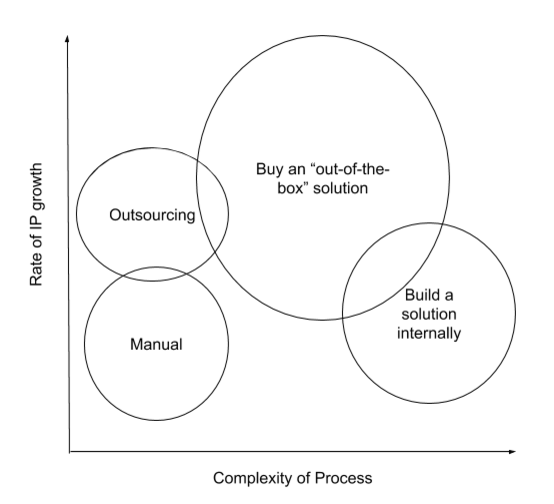Developing a process to manage your organization’s intellectual property (IP) can be challenging. A process needs to be built based on best practices and efficiently enabled. There are a few options and it can be difficult to know which is right for your organization. Here’s a brief breakdown of each option: manual, outsourcing, building an in-house solution, or buying “out-of-the-box” IP management software.
Manual Processes
Using paper files or spreadsheets to manage intellectual property assets and their details.
Pros:
- Lower upfront costs - Using cheap or free tools like paper and spreadsheets, means that the initial investment in IP management will be less than that of a formal IP management tool.
- Easy - What can you say? For some people, old school is the easiest and most comfortable way to go.
Cons:
- Someone could get hit by a bus. Continuity of information is crucial. Even the most organized of teams run the risk of losing important information when they handle it manually. Using this type of system can lead to the loss of important details.
- Inability to strategically leverage - One of the biggest inefficiencies of disparate files is the inability to see the big picture. This means that you could be missing critical opportunities to leverage IP strategically.
- Higher long-term costs - In the world of IP management, spreadsheets, emails, file folders and banker boxes are one-dimensional tools trying to solve a three-dimensional problem. If you don’t understand not just your inventory, but how it’s connected to other assets, people and activities, one miss could cost you dearly in the long-run.
Is my organization a good fit for this method?
All-in-all, a manual IP management process can be a good choice for an organization with little complexity and few IP assets to manage. However, when looking at the best method for you, consider the significance of having good infrastructure that can scale as the business expands and grows.
Outsourcing
Handing off IP management to an outside legal or IP team focused on intellectual property services
Pros:
- Lighter internal workload - Handing off your organization’s IP management process can give your team more time and human resources which can be spent pursuing other important objectives.
- Expert management - Lawyers or other services specializing in intellectual property have expertise in the industry and can share best practices to help make your organization’s IP more valuable.
Cons:
- Expensive - If you’re looking to contain costs, outsourcing is additive when compared with good internal systems, tools and technologies.
- Loss of visibility - Moving IP management externally reduces your organization’s visibility and can hinder your ability to effectively leverage assets.
- Loss of control - Although it is exceptionally rare, outsourcing IP management can result in infringement and put your IP assets in danger. It’s critical to work only with reputable and trusted partners.
Is my organization a good fit for this method?
Outsourcing may be a good fit for a growing organization with a small IP team whose resources are needed elsewhere or who cannot make the financial investment in hiring dedicated IP resources.
Building a system internally
Developing, with the internal IT team, an IP management system from scratch or trying to leverage suboptimal tools.
Pros:
- Ultimate customization - A system developed from scratch tailors exactly to your organization’s unique requirements and perhaps connects more readily to other internal processes like contract and risk management.
- High integration capacity - Similarly, a custom-built system can be coded to integrate with any other software you use internally.
Cons:
- Implementation and maintenance challenges - Building any solution from scratch is a large undertaking that involves both political and technical work. Gaining buy-in, defining requirements, building the solution and managing change could delay your initiative considerably. Maintaining the system requires continuity of knowledge (ever have any IT turnover?) and great documentation.
- High risk of failure - Undertaking an internal development project can be tricky, and many lead to failure. Aside from even getting your project on the IT team’s radar, internal systems can commonly lead to feature oversights and gaps in knowledge as employees leave the organization.
Is my organization a good fit for this method?
In order to develop internally, an organization needs to have a fully resourced IT department with the bandwidth to take on a large development process. Even so, the IP management process should have a high level of complexity and uniqueness to balance out the risk of such a large project.
Buy an out-of-the-box solution
Buying IP management software from an external vendor.
Pros:
- Shorter time to implementation - Starting with pre-built IP management software allows you to skip the development phase of the project and move right to implementation.
- Built on best practices - Using IP management software created by an industry expert allows your company to learn more about and follow common best practices. Additionally, an external solution will undergo regular product enhancements that an internal solution might not.
- High scalability - Since an out-of-the-box solution standardizes your IP management process, keeps important details housed in one common system, and usually offers technical support, this method is highly scalable for growing organizations. Good IP management systems can also be quickly configured to meet your changing needs.
Cons:
- Higher upfront costs - Pre-built IP management software can seem pricey upfront compared to other methods (though that’s not always the case). However, often the long-term cost savings justify the initial expense.
- May impose process change - For organizations with unique IP management processes, using a pre-built solution may feel like fitting a square peg into a round hole. However, these solutions tend to be highly customizable, with interchangeable modules to fit your process.
Is my organization a good fit for this method?
Pre-built IP management software tends to be the best choice for the majority of organizations. These solutions allow for the highest scalability, adoption of best practices, reasonable customization, and visibility into an expansive IP portfolio. As such it can work well for everyone from organizations in their infancy that want good infrastructure all the way up to the mature organization looking to leverage their IP assets more effectively.
For more information on intellectual property management systems and what’s right for you, download this free whitepaper.


